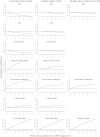Accounting for individual differences and timing of events: estimating the effect of treatment on criminal convictions in heroin users
- PMID: 24886472
- PMCID: PMC4040473
- DOI: 10.1186/1471-2288-14-68
Accounting for individual differences and timing of events: estimating the effect of treatment on criminal convictions in heroin users
Abstract
Background: The reduction of crime is an important outcome of opioid maintenance treatment (OMT). Criminal intensity and treatment regimes vary among OMT patients, but this is rarely adjusted for in statistical analyses, which tend to focus on cohort incidence rates and rate ratios. The purpose of this work was to estimate the relationship between treatment and criminal convictions among OMT patients, adjusting for individual covariate information and timing of events, fitting time-to-event regression models of increasing complexity.
Methods: National criminal records were cross linked with treatment data on 3221 patients starting OMT in Norway 1997-2003. In addition to calculating cohort incidence rates, criminal convictions was modelled as a recurrent event dependent variable, and treatment a time-dependent covariate, in Cox proportional hazards, Aalen's additive hazards, and semi-parametric additive hazards regression models. Both fixed and dynamic covariates were included.
Results: During OMT, the number of days with criminal convictions for the cohort as a whole was 61% lower than when not in treatment. OMT was associated with reduced number of days with criminal convictions in all time-to-event regression models, but the hazard ratio (95% CI) was strongly attenuated when adjusting for covariates; from 0.40 (0.35, 0.45) in a univariate model to 0.79 (0.72, 0.87) in a fully adjusted model. The hazard was lower for females and decreasing with older age, while increasing with high numbers of criminal convictions prior to application to OMT (all p < 0.001). The strongest predictors were level of criminal activity prior to entering into OMT, and having a recent criminal conviction (both p < 0.001). The effect of several predictors was significantly time-varying with their effects diminishing over time.
Conclusions: Analyzing complex observational data regarding to fixed factors only overlooks important temporal information, and naïve cohort level incidence rates might result in biased estimates of the effect of interventions. Applying time-to-event regression models, properly adjusting for individual covariate information and timing of various events, allows for more precise and reliable effect estimates, as well as painting a more nuanced picture that can aid health care professionals and policy makers.
Figures



Similar articles
-
A day-by-day investigation of changes in criminal convictions before and after entering and leaving opioid maintenance treatment: a national cohort study.BMC Psychiatry. 2013 Oct 16;13:262. doi: 10.1186/1471-244X-13-262. BMC Psychiatry. 2013. PMID: 24131480 Free PMC article.
-
Criminal convictions among dependent heroin users during a 3-year period prior to opioid maintenance treatment: a longitudinal national cohort study.J Subst Abuse Treat. 2011 Dec;41(4):407-14. doi: 10.1016/j.jsat.2011.06.006. Epub 2011 Aug 11. J Subst Abuse Treat. 2011. PMID: 21839605
-
Driving under the influence (DUI) among patients in opioid maintenance treatment (OMT): a registry-based national cohort study.Addiction. 2013 Nov;108(11):1954-61. doi: 10.1111/add.12275. Epub 2013 Jul 19. Addiction. 2013. PMID: 23773400
-
Engagement with opioid maintenance treatment and reductions in crime: a longitudinal national cohort study.Addiction. 2012 Feb;107(2):393-9. doi: 10.1111/j.1360-0443.2011.03637.x. Epub 2011 Oct 26. Addiction. 2012. PMID: 21883606
-
Reductions in convictions for violent crime during opioid maintenance treatment: a longitudinal national cohort study.Drug Alcohol Depend. 2012 Aug 1;124(3):307-10. doi: 10.1016/j.drugalcdep.2012.02.005. Epub 2012 Feb 28. Drug Alcohol Depend. 2012. PMID: 22382045
Cited by
-
Incidence of future arrests in adults involved in the criminal justice system with opioid use disorder receiving extended release naltrexone compared to treatment as usual.Drug Alcohol Depend. 2019 Jan 1;194:482-486. doi: 10.1016/j.drugalcdep.2018.10.035. Epub 2018 Dec 3. Drug Alcohol Depend. 2019. PMID: 30522048 Free PMC article. Clinical Trial.
-
How handling missing data may impact conclusions: A comparison of six different imputation methods for categorical questionnaire data.SAGE Open Med. 2019 Jan 8;7:2050312118822912. doi: 10.1177/2050312118822912. eCollection 2019. SAGE Open Med. 2019. PMID: 30671242 Free PMC article.
-
History of the discovery, development, and FDA-approval of buprenorphine medications for the treatment of opioid use disorder.Drug Alcohol Depend Rep. 2023 Jan 10;6:100133. doi: 10.1016/j.dadr.2023.100133. eCollection 2023 Mar. Drug Alcohol Depend Rep. 2023. PMID: 36994370 Free PMC article. Review.
-
Psychiatric illness and the risk of reoffending: recurrent event analysis for an Australian birth cohort.BMC Psychiatry. 2023 May 23;23(1):355. doi: 10.1186/s12888-023-04839-0. BMC Psychiatry. 2023. PMID: 37221485 Free PMC article.
References
-
- Sudre P, Rickenbach M, Taffé P, Janin P, Volkart AC, Francioli P, Swiss HIVCS. Clinical epidemiology and research on HIV infection in Switzerland: the Swiss HIV Cohort Study 1988–2000. Schweiz Med Wochenschr. 2000;130(41):1493–1500. - PubMed
-
- Røysland K, Gran JM, Ledergerber B, von Wyl V, Young J, Aalen OO. Analyzing direct and indirect effects of treatment using dynamic path analysis applied to data from the Swiss HIV Cohort Study. Stat Med. 2011;30(24):2947–2958. - PubMed
-
- Moncino MD, Falletta JM. Multiple relapses of clostridium difficile-associated diarrhea in a cancer patient: successful control with long-term cholestyramine therapy. J Pediatr Hematol Oncol. 1992;14(4):4. - PubMed
-
- Pestalozzi BC, Holmes E, de Azambuja E, Metzger-Filho O, Hogge L, Scullion M, Láng I, Wardley A, Lichinitser M, Sanchez RIL, Müller V, Dodwell D, Gelber RD, Piccart-Gebhart MJ, Cameron D. CNS relapses in patients with HER2-positive early breast cancer who have and have not received adjuvant trastuzumab: a retrospective substudy of the HERA trial (BIG 1–01) Lancet Oncol. 2013;14(3):244–248. - PubMed
-
- Gossop M, Marsden J, Stewart D, Rolfe A. Patterns of improvement after methadone treatment: 1 year follow-up results from the National Treatment Outcome Research Study (NTORS) Drug Alcohol Depend. 2000;60(3):275–286. - PubMed
MeSH terms
LinkOut - more resources
Full Text Sources
Other Literature Sources
Medical

